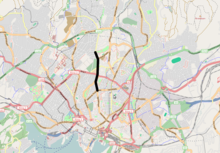
Back Austkanten og vestkanten i Oslo NN Østkant og vestkant i Oslo NB Östkanten och västkanten i Oslo Swedish

The East End and West End (Bokmål: østkanten og vestkanten, Nynorsk: austkanten og vestkanten) are used as names for the two parts of Oslo, Norway, formed by the economic and socially segregating separation line that has historically passed along the street Uelands gate. The Akerselva river is often seen as a boundary between west and east, but that can be misleading, as there are working-class neighbourhoods on both sides of the river.
The West End was built in the 1840s, and had since the 17th century been a common land area, with the area behind the castle as an exit point. The East End grew around the new industry and along the passageways to the east. Around 1890, the division between east and west was prominent and most districts of the city were marked by class, either by working-class or bourgeois class. This division was reflected in architecture, but also in politics in that the Conservative Party and the Labour Party were, taken together, much more dominant than in other parts of Norway. The dialects have traditionally been quite different, and there has been a sharp distinction line between the sociolects of the two parts of the city, but this has somewhat diminished in the latest decades. Youths who have grown up in one part of the city usually have little experience of the other[citation needed].
The West End districts (boroughs), districts number 4, 5, 6, 7 and 8, have a total population of about 202,000 as of 1 January 2011, while the East End districts have a total population of about 405,000 (January 2011).[1]
In the East End, wealth, incomes and real estate prices are significantly lower than in the West End. Both the worst and the best living conditions in Norway can be found in Oslo.[citation needed] The economic difference is strengthened by the cultural capital of those who belong to the elite: social networks, education and activities that provide access to attractive jobs and other benefits.[citation needed] The distinction between east and west also concerns life expectancy, use of disability pension and self-experienced health conditions.[citation needed]
Since the 1970s, the great immigration to Oslo has influenced the city, concerning the distinction between east and west. Immigrants from Western Europe and North America are equally divided among the city's two parts, whereas most immigrants from Asia, Africa and Eastern Europe live in the East End. The worst living conditions can be found among immigrants from continents other than Europe.
Even though the districts in the East End of Oslo are among the worst in the city, they have relatively good living conditions and quality of education compared to the worst parts of most other major cities in Europe. Class distinctions play a smaller role for the majority of the population than in many other countries, and the good economic quality and living conditions of the Norwegian society are also reflected in the capital. What makes Oslo special is the lingering geographic class division of the city into two parts that has existed for almost 150 years.
- ^ Tabell 4. Befolkningen i Oslo etter bydel, rode (grunnkrets) og alder pr. 01.01.2009, side 40 i: Notatserien 2/2009. Oslo kommune, Utviklings- og kompetanseetaten. Archived 2011-06-11 at the Wayback Machine Rodene 204-209 (Fredensborg och Hausmannsområdet) in the district St. Hanshaugen with a population of about 2500 has been included in the East End